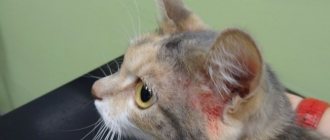Causes of itching in the head and neck area in cats
Cats scratch their necks until they hurt for a variety of reasons. This behavior is provoked by external factors, ectoparasites and a number of diseases of varying degrees of danger. The largest number of cases are due to allergies and insect parasites. A smaller percentage of the probability is associated with viral, autoimmune and other diseases.
Ectoparasitosis
Otodectes cynotis, or ear scabies, is caused by mites. They settle in the ears or ear canal and cause severe itching in the cat. As a result, she regularly shakes her head and scratches her ears until they hurt. It is transmitted by contact and affects mainly young animals.
Notoedrosis or pruritic scabies develops against the background of Notoedres cati tick bites. The disease is characterized by inflammation of the scalp, hair loss and severe itching. An infected cat constantly scratches its head until sores appear.
Important! Notoedres cati itches spread from cats to other animals and even humans. For some time they cause pseudo-scabies and then go away, since there are no favorable conditions for life.
Cheyletiellosis, or wandering scabies, is caused by Cheyletiella mites. The fact that a cat has these parasites is indicated by severe itching and fine dandruff. The disease often spreads to humans and causes an itchy rash.
Demodectic mange or ironworm is the result of exposure to mites of the genus Demodex. They develop their vital activity in the sebaceous glands and hair follicles. As a result, bald patches of skin and sores appear on the cats’ faces. The areas most commonly affected are the areas around the eyes and mouth, as well as the front legs.
Fleas are a common cause of scratching on the neck and other parts of the body. They parasitize primarily on cats and dogs. They can also temporarily transfer to humans. When infected with them, a large number of black crumbs appear under the fur of pets. These flea droppings are especially noticeable in the lumbar and back areas.
The animals themselves itch very much to the point of soreness, as they experience severe itching at the bite sites.
Allergies
A common reason why a cat scratches itself until it hurts is allergies. It implies an abnormal reaction of the body to a stimulus. When first hit, protective cells create an antidote and “remember” the allergen. And if it penetrates again, a violent reaction occurs in the body. It leads to inflammation, itching and other symptoms.
Allergies cause several diseases in cats:
- atopic dermatitis;
- flea dermatitis;
- food allergies;
- contact dermatitis.
Flea dermatitis
Flea dermatitis is a common reason why a cat scratches itself until it hurts. When one flea bites, it releases a special anticoagulant into the cat's skin. This substance prevents blood clotting. The pet becomes sensitized to it. And the body reacts to the bites of other fleas in the form of inflammatory processes, rashes and papules.
The affected areas are very itchy. The cat begins to behave restlessly and reacts nervously to touch. This type of dermatitis occurs in two forms: chronic and latent. In the first case, alopecia (foci of baldness) and nodules with flea feces develop on the body. The second is characterized by the appearance of papules with a red rim.
The cat begins to tear them apart until they hurt. Often secondary infection is associated with wounds.
Atopic dermatitis
The disease is typical for young animals aged 1 to 3 years. The main reason for its appearance is the uncontrolled selection of cats. As a result, animals develop allergies to dust and pollen. In this case, it is almost impossible to identify the allergen.
Important! Atopic dermatitis has no cure; cats will regularly scratch their skin until it hurts. The action of therapy is aimed at suppressing symptoms.
Dermatitis in cats manifests itself with the following symptoms:
- the appearance of dandruff on the withers and back;
- hair loss;
- labored breathing;
- discharge from the eyes and nose;
- cough;
- profuse salivation.
Contact dermatitis
This allergy is similar in symptoms to atopic dermatitis. It often manifests itself when the pet comes into contact with household chemicals, toilet filler, the hair of other animals, and flea products. Contact allergies are manifested by severe itching, flaking of the skin and a small rash. Often a cat itches until it hurts. And this increases the risk of secondary infections.
Food allergies
Allergens can accumulate in the body of animals. With their regular consumption, health problems begin. Food allergies are characterized by:
- the appearance of a rash on the cat’s neck and head;
- hair loss;
- the appearance of dandruff;
- inflammation of the eyelids;
- unpleasant odor from the mouth.
Important! Symptoms of food allergies in cats are often accompanied by vomiting and indigestion.
A common cause of food allergies is feeding cats salted, fried, smoked and other prohibited foods from the table. Mixed feeding with industrial feed and natural products also contributes to its appearance.
Miliary dermatitis
When the disease affects the neck area and manifests itself as scatterings of small pimples, miliary dermatitis is first suspected, which is always a consequence of other pathologies. It is even more expedient to talk about it, not as a separate sore, but as a symptom of another ailment. The doctor will tell you exactly what pathology caused this type of dermatitis after the diagnosis. It is impossible to do this on your own.
© shutterstock
Often a rash on the neck becomes a manifestation of a food allergy. Among the causes are also subcutaneous mites. Treatment will depend on what exactly caused the skin sore. By the way, rashes can appear not only on the cat’s neck, but also on other parts of the body.
Skin infections
Scratched cat sores on the neck and head in some cases occur due to infectious diseases. Cats with access to the outdoors are especially susceptible to them. When a bacterial infection of the skin occurs, one of two forms develops:
- Dry. Dry crusts, dandruff and scabs form on your cat's neck.
- Wet. It is characterized by the appearance of blisters and ulcers with liquid contents inside.
Animals with sensitive skin are predisposed to eczema. It develops through prolonged contact with flea collars, harnesses, after insect bites and skin parasites.
Important! Diabetes mellitus, neuropathy and hormonal changes contribute to the appearance of eczema.
A rash and blisters appear on the pet's body. Severe itching leads to the cat scratching its neck until it bleeds, and sores appear that do not go away for a long time. To eliminate eczema, antibacterial therapy, various ointments and powders are prescribed.
Viral dermatoses
Cat scratching on the skin is also characteristic of viral dermatoses. The herpes virus affects the eyes and respiratory tract of the animal, often manifesting itself as skin lesions. They are often localized in the area of the nose and eyes, less often on the paws and stomach.
Feline herpes is characterized by:
- bloody stains;
- small rash;
- swelling of the skin;
- small scabs on the neck, sores on the head.
Skin changes appear 1.5 weeks after the disappearance of conjunctivitis and other characteristic symptoms.
Cowpox or poxvirus is a rare disease. It can enter the cat's body through the bites of small rodents. It manifests itself as skin lesions in the form of nodules and small ulcers. With good immunity, it goes away on its own. In weakened animals there is a risk of developing a severe form.
Autoimmune dermatoses
Autoimmune diseases are characterized by an abnormal reaction of the immune system to its own tissues and cells. Skin manifestations on the body of cats are characteristic of several diseases:
- Common pemphigus. It is characterized by the development of ulcers in cats around the mouth and in its cavity itself. Involves long and difficult treatment. It often ends critically for animals.
- Erythematous pemphigus. Crusts, ulcers, blisters, sores and other lesions are concentrated in the area of the animal’s nose and bridge of the nose. Sometimes the disease is accompanied by a change in skin color.
- Pemphigus foliaceus. The main symptom is the appearance of large pustules on the skin near the mouth and ears. Associated signs in cats include elevated body temperature, refusal to eat, and apathy.
- Systemic lupus erythematosus. It affects all systems and organs of the animal. Wounds on the scalp manifest themselves through depigmentation of the skin, the development of a rash and the subsequent formation of ulcers.
Necessary treatment
When the owners notice a spot on a cat, due to which it has severely scratched the skin, they should not delay contacting the veterinarian. After a comprehensive diagnosis, the specialist will select the necessary therapeutic measures to eliminate the problem. If wounds on the neck are associated with flea activity, then it is necessary to treat the animal’s fur and skin, and other treatment methods are also used:
- using a special collar;
- pills;
- external treatments such as shampoo, spray or powders;
- local action drops.
To prevent infection in wounds in the neck area, they must be regularly wiped with hydrogen peroxide, iodine or other antiseptics. When formations are accompanied by the release of purulent fluid, a course of antibacterial therapy is required. If the problem lies in an allergic reaction, then it is necessary to exclude the cat’s contact with the allergen. In the absence of positive dynamics, antihistamines are prescribed. It is possible to combat wounds on the neck with other means presented in the table:
| Disease | Recommended Medicines | |
| External | Domestic | |
| Ringworm | Nystatin ointment | "Ketoconazole" |
| Griseofulvinic | "Griseofulvin" | |
| Subcutaneous mite | "Frontline" | "Ivermek" |
| "Stronghold" | ||
| "Advocate" | ||
| "Amit Forte" | ||
Under no circumstances should you smear unknown products or treat the fur and skin in the neck area of the animal with medications at your own discretion. This is due to the fact that many drugs have contraindications and can lead to complications, including death.
Skin tumors
Skin neoplasms are in first place among oncological diseases in animals. By their nature, they are also divided into benign and malignant forms.
The first includes:
- Basalioma. The sore is a pigmented dome-shaped tumor. At the point where it appears, the animal loses its hair.
- Cutaneous histiocytoma. Characterized by a rapidly growing tumor under the skin. A rare pathology for cats.
Malignant skin tumors develop in two cases:
- Squamous cell carcinoma. The disease manifests itself in the nose, eyelids and ears. Metastases spread through the lymphatic system.
- Basal cell carcinoma. Develops from basal cells of the skin. Characterized by rapid growth and a high probability of metastasis.
Getting rid of itching is not the solution
First of all, owners strive to alleviate the condition of their pet. If you apply standard allergy treatment, the symptoms will return after a while. It is necessary to use local remedies that dry the wounds and alleviate the condition, but this is not the main focus. Therefore, the main task is to find the real reason for what is happening. Only after diagnosis can effective treatment be prescribed.
Any skin disease takes a long time to cure, so don’t be discouraged if there are no quick results. The most important thing is your attention and the support of an experienced doctor.
History taking
Diagnostics will help you understand why your cat scratches its neck and what caused the sores. But before carrying it out, the veterinarian needs to collect an anamnesis.
Age and breed
A kitten up to one year old is susceptible to skin and subcutaneous parasites. Young animals suffer predominantly from allergic reactions. If an elderly cat scratches its neck until it bleeds and hurts, this may be due to autoimmune dermatoses.
The breed of the animal also leaves its mark. Persian cats are prone to dermatophytosis and dermatitis, while Sphynx cats are prone to allergies and neoplasms.
Lifestyle
A large number of animals in one area, access to the street, participation in cat shows and other factors increase the risk of infection with parasites and viral diseases.
Seasonality
Allergies to pollen, bee or mosquito bites have a pronounced seasonality. Flea dermatitis in cats manifests itself regardless of the time of year. But it is most common in August-September.
Bacterial dermatitis
There is also a type of dermatitis called bacterial. It can also cause ulcers on the neck. As the name implies, it is provoked by pathogenic bacteria. Often other diseases become the impetus for development. In particular, allergies, demodicosis, pathologies of the endocrine system.
The pain is very bad. It manifests itself as itchy wounds, the area of which steadily expands without treatment. As a result, a huge bleeding spot is observed on the skin. In advanced stages, bacterial dermatitis can cause an abscess, and the formation of fistulas and nodes is also possible.
Moreover, they are much more difficult to cure than an ordinary ulcer. If you find sores on the neck, you should immediately show your cat to a doctor in order to start therapy on time and avoid serious consequences. Self-medication of bacterial dermatitis is strongly discouraged. Moreover, there is no single scheme. It is selected individually.
Diagnostic methods
Diagnostics will help determine why a cat scratches its neck until it hurts. The doctor prescribes one or more methods:
- Combing wool. A fine comb is used for this. The procedure allows you to see fleas, lice and skin mites on cats. Can be done independently at home.
- Trichogramma. Determines the presence of spores and eggs on the hair shaft.
- Examination of earwax under a microscope. It is carried out if otodectosis is suspected.
- Wood's lamp. Shows the glow of spores on the skin of an animal from certain types of fungus.
- Cytological examination. The veterinarian recommends this to detect yeast and bacterial infections.
- Allergy test. Prescribed for confirmed atopic allergies in cats.
- Skin scraping. Detects ticks, their larvae, and spores.
- Elimination diet. Prescribed by a veterinarian to determine the allergen for food allergies.
- Fungal culture. An effective method for dermatophytes.
The cat itches until it hurts and the hair falls out: How to treat it at home?
Every owner should understand that many drugs that can be used by humans and other animals cannot be used on cats.
For example, skin lesions are often treated with Yam BK ointment. This is strictly forbidden, since the tar contained in this drug is toxic to cats.
Like this article? Read other materials about cats on our website: How to give medicine to a cat? Tips for ensuring comfort for a cat - How to learn to understand your cat (Practical tips) -
How can you help yourself without causing harm?
Try to limit access to the body area if the cat injures itself. A protective collar or blanket can help with this.
Trim your cat's claws or apply safe anti-scratch pads.
Itching can be controlled using a suspension or spray with the same name Stop Itching . It is important to understand that you will only remove the symptom, and after a course of the drug the problem may return.
The crusts can be soaked and removed using saline or Chlorhexedine.
Also, if there has been no treatment for fleas and ticks for a long time (the apple tree is a month old), it is worth doing it. Suitable drugs: Stronghold, Lawyer, Helmintal, Inspector, Bravecto.
And, of course, we recommend taking your pet to see a doctor as soon as possible.










